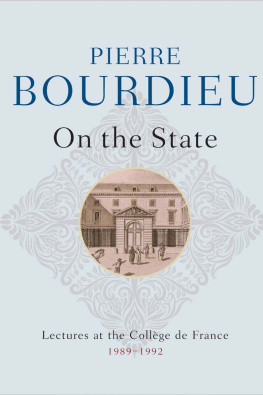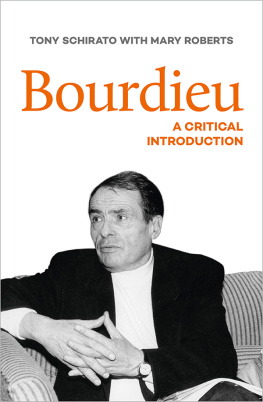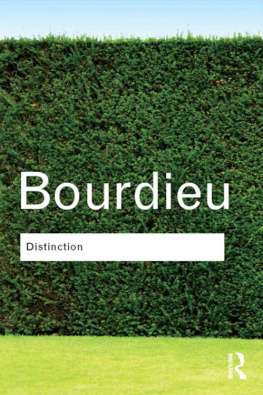Contents
Guide
Pages

Manet
Pierre Bourdieu
A Symbolic Revolution
Lectures at the Collge de France (19982000) followed by an unfinished manuscript by Pierre and Marie-Claire Bourdieu
Edition established by Pascale Casanova, Patrick Champagne, Christophe Charle, Franck Poupeau and Marie-Christine Rivire
Opus Infinitum, by Christophe Charle
Self-Portrait as a Free Artist, by Pascale Casanova
Translated by
Peter Collier and Margaret Rigaud-Drayton
polity
First published in French as Manet. Une rvolution symbolique ditions Raisons dAgir/ ditions du Seuil, 2013
This English edition Polity Press, 2017
Cet ouvrage a bnfici du soutien des Programmes daide la publication de lInstitut franais.
This work, published as part of a program of aid for publication, received support from the Institut Franais.
Polity Press
65 Bridge Street
Cambridge CB2 1UR, UK
Polity Press
101 Station Landing, Suite 300
Medford, MA 02155, USA
All rights reserved. Except for the quotation of short passages for the purpose of criticism and review, no part of this publication may be reproduced, stored in a retrieval system or transmitted, in any form or by any means, electronic, mechanical, photocopying, recording or otherwise, without the prior permission of the publisher.
ISBN-13: 978-1-5095-0009-3
A catalogue record for this book is available from the British Library.
Library of Congress Cataloging-in-Publication Data
Names: Bourdieu, Pierre, 1930-2002, author.
Title: Manet : a symbolic revolution / Pierre Bourdieu.
Other titles: Manet. English
Description: English edition. | Malden, MA : Polity Press, 2017. | Includes bibliographical references and index.
Identifiers: LCCN 2017002454 | ISBN 9781509500093 (hardback)
Subjects: LCSH: Manet, Edouard, 1832-1883--Criticism and interpretation. | Art and society.
Classification: LCC ND553.M3 B6813 2017 | DDC 759.4--dc23 LC record available at https://lccn.loc.gov/2017002454
The publisher has used its best endeavours to ensure that the URLs for external websites referred to in this book are correct and active at the time of going to press. However, the publisher has no responsibility for the websites and can make no guarantee that a site will remain live or that the content is or will remain appropriate.
Every effort has been made to trace all copyright holders, but if any have been inadvertently overlooked the publisher will be pleased to include any necessary credits in any subsequent reprint or edition.
For further information on Polity, visit our website: politybooks.com
Acknowledgements
We would like to thank Bruno Auerbach, Laure Bourdieu, Simon Bourdieu, Ins Champey, Olivier Christin, Adrien Fischer and Gilles LHte for their contribution to this book. We also express our gratitude to all the individuals in and outside France who were consulted by Pierre Bourdieu and helped him with this project on Manet, especially his two direct collaborators, Rosine Christin and Martine Dv.
Editors Note
This volume combines the lectures that Pierre Bourdieu gave on Manet at the Collge de France in 1999 and 2000, with an unfinished book on the same artist written in collaboration with his wife Marie-Claire Bourdieu, who, after contributing to the research for the book, ended up helping to shape its very conception. Both the title of the book and the titles of the two years of lectures were chosen by the editors. The guidelines used to establish the texts follow the editorial policy adopted for the publication of Sur ltat in 2012.
Our transcription of Bourdieus lectures at the Collge de France respects the approach taken by Bourdieu when he himself revised his lectures and seminars: polishing the style, ironing out the rough edges of oral discourse (repetitions, slips of the tongue, etc.) and suppressing some developments that are off the topic or too impromptu. Beyond these general principles, other changes were necessary because of the unfinished nature of the argument, as Bourdieu himself recognized. More precisely, one of the interesting aspects of this publication is that it is a work in progress, which reveals a process of thinking. This explains why there are some changes in the content of a planned expos, hesitations, interrupted arguments, partly improvised or merely sketched topoi, and occasional repetitions or reminders designed to capture the attention of the audience: although these things were not a problem when the lectures were delivered, they would have rendered the reading of an overliteral transcription difficult. Even though there was never any question of rewriting the lectures in the way that Bourdieu himself would have done, some structural reshaping was nonetheless necessary, since he did not write out his lectures, but used his notes to speak his thoughts out loud and felt free to follow up ideas that occurred to him during the course of his expos. Where these developments address the topic at issue, they are placed between dashes; where they indicate a break in the argument, they are noted in brackets; and where they are too long, they may become the subject of a separate section. The editors are responsible for the division of the text into sections and paragraphs, as well as for its subtitles and punctuation, and for the footnotes that provide references to the works mentioned and explain some of the allusions. So as not to overburden the critical apparatus, the choice was made to restrict all non-bibliographical notes to the information necessary for the elucidation of an allusive passage, or to the contextualization of items too summarily mentioned. However, when Bourdieu mentions the artists and critics who were Manets contemporaries, particularly those less well known, he usually provides their biographical details during the lectures as and when the argument requires it.
In the manuscript of the book, the bibliographical references indicated by the authors have been complemented when they were not sufficiently informative. Similarly, in the lectures, some notes have been added to facilitate the understanding of the text: explanations, cross-references, complementary details. As we have said, this book remained unfinished: the fully developed passages of the manuscript are interrupted by other passages of varying length, either in the form of rough drafts, indicated by italics, or sometimes by notes left in their raw state, which we have decided to publish despite their fragmentary nature. This is because they give an idea of how Bourdieu worked and provide insights into his writing process. Although the juxtaposition of the lectures and the manuscript does sometimes give rise to a number of repetitions, we chose not to use this criterion to make cuts, considering that the value of the complementary information they provide outweighs the disadvantages of repetition. On the other hand, we made other cuts, for reasons that will be clarified as and when they occur.
A text by Christophe Charle, Opus Infinitum, highlights the links between the lectures and the manuscript, situates these studies of Manet in the sociologists work and reconstructs their genesis. Drawing up a report on the research undertaken since, he gives an idea of potential developments and revisions of the perspectives opened by Bourdieu. And finally, a brief postface by Pascale Casanova, Self-Portrait as a Free Artist, closes this collection. She evokes the parallels between the painter and the sociologist, which comprise one of the driving forces of Bourdieus analysis of Manet. She also reminds us of the high cost of being a symbolic revolutionary, and of how improbable it was for someone to do that very strange thing, as Bourdieu said, i.e., turning their mastery of a system against the system itself in order to subvert it.











